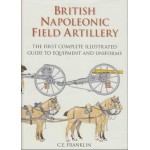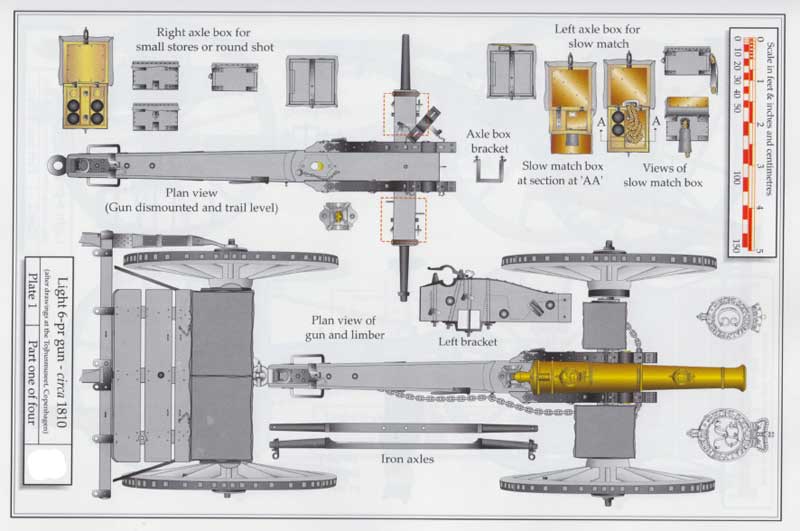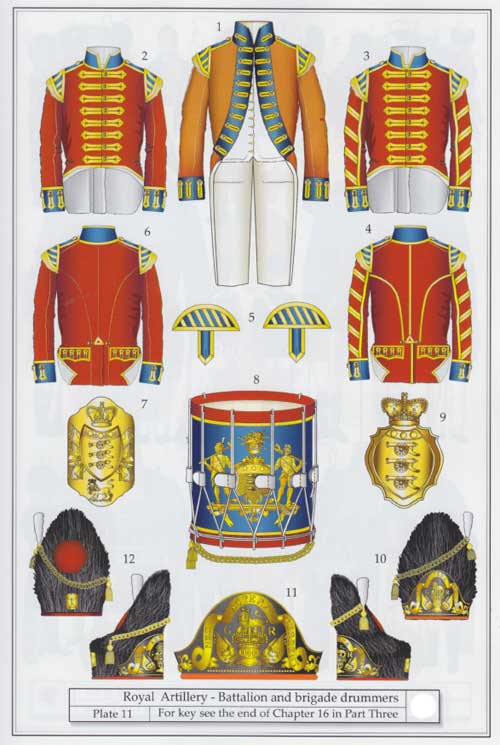| Home » Online Shop » British Army Uniforms |
British Napoleonic Field Artillery

|
|
British Napoleonic Field Artillery

By Carl Franklin
Format-PDF
200 MB
The first phase of the Napoleonic War began when France declared war on Britain, Spain and Holland in February 1793 and continued until the peace of Amiens in March 1802.
The peace was not destined to last and in May 1803, Britain declared war on France and the second phase of the war continued until after June 1815 when Napoleon abdicated. The history of any famous regiment invariably considers the men, the theatres of operation and usually in a much smaller way, the equipment.
In the case of the Royal Artillery this is due to the apparent absence of any surviving gun carriages and limbers and most of the previous studies have limited themselves to the comparisons with the anachronistic material of earlier and later periods. This compendium draws together new and existing contemporary information that provides new insights into the field equipment and uniforms of the period. While some of the material has been published before much is placed into the public domain for the first time.
The ordnance considered by this book is limited to the field artillery and the supporting equipments. The role of field artillery was to support the army in the field and in this context the Royal Regiment of Artillery had two fighting arms, the Royal Artillery and the Royal Horse Artillery. The Royal Artillery supported the infantry and was formed into 'Brigades', the gunners marching with the guns. The Royal Horse Artillery supported the cavalry and was formed in 'Troops', with all the gunners mounted or riding on the equipment.
The field pieces of this period were bronze, smooth-bore weapons and the inventory of the field artillery was made up from the light and heavy 3-pr, the light, heavy and long 6-pr, and the medium 12-pr. Later, after 1808, came the 9-pr; also included in the field inventory were the light and heavy 5.5-inch howitzers and the iron 24-pr howitzer. There were trials with other ordnance but none was taken into full service, so these are not considered nor is the ordnance associated with the garrison and siege artillery. In addition to field equipments, this book also addresses the different gun carriages, limbers, ammunition wagons, other supporting equipment, the drills and exercises, and the uniforms of the period.
The peace was not destined to last and in May 1803, Britain declared war on France and the second phase of the war continued until after June 1815 when Napoleon abdicated. The history of any famous regiment invariably considers the men, the theatres of operation and usually in a much smaller way, the equipment.
In the case of the Royal Artillery this is due to the apparent absence of any surviving gun carriages and limbers and most of the previous studies have limited themselves to the comparisons with the anachronistic material of earlier and later periods. This compendium draws together new and existing contemporary information that provides new insights into the field equipment and uniforms of the period. While some of the material has been published before much is placed into the public domain for the first time.
The ordnance considered by this book is limited to the field artillery and the supporting equipments. The role of field artillery was to support the army in the field and in this context the Royal Regiment of Artillery had two fighting arms, the Royal Artillery and the Royal Horse Artillery. The Royal Artillery supported the infantry and was formed into 'Brigades', the gunners marching with the guns. The Royal Horse Artillery supported the cavalry and was formed in 'Troops', with all the gunners mounted or riding on the equipment.
The field pieces of this period were bronze, smooth-bore weapons and the inventory of the field artillery was made up from the light and heavy 3-pr, the light, heavy and long 6-pr, and the medium 12-pr. Later, after 1808, came the 9-pr; also included in the field inventory were the light and heavy 5.5-inch howitzers and the iron 24-pr howitzer. There were trials with other ordnance but none was taken into full service, so these are not considered nor is the ordnance associated with the garrison and siege artillery. In addition to field equipments, this book also addresses the different gun carriages, limbers, ammunition wagons, other supporting equipment, the drills and exercises, and the uniforms of the period.
ONCE PAYMENT IS CONFIRMED,
DOWNLOAD LINK WILL BE SENT DIRECTLY TO YOUR EMAIL!
DOWNLOAD WILL BE HOSTED
DOWNLOAD LINK WILL BE SENT DIRECTLY TO YOUR EMAIL!
DOWNLOAD WILL BE HOSTED
OFF MY OWN SERVER.
or recording on CD or DVD and send to your adress
At the order of 5 and more things - the discount of 5 %
At the order of 10 and more things - the discount of 10 %
At the order of 20 and more things - the discount of 20 %
At a choice any 20 and more books (items) , magazines enters the name on CD or DVD and it is sent on your address free of charge. FREE SHIPING!
or recording on CD or DVD and send to your adress
At the order of 5 and more things - the discount of 5 %
At the order of 10 and more things - the discount of 10 %
At the order of 20 and more things - the discount of 20 %
At a choice any 20 and more books (items) , magazines enters the name on CD or DVD and it is sent on your address free of charge. FREE SHIPING!

